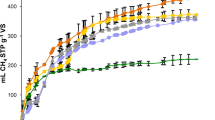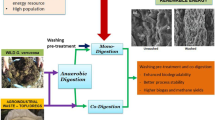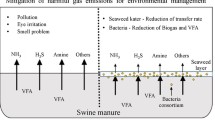Abstract
Traditionally, anaerobic digestion (AD) is applied for the simultaneous generation of energy and treatment of various organic wastes. For example, despite orange peels (OP) and seaweed (SW) are highly available for AD, their physicochemical composition can inhibit the microbiome and collapse the process. In the present work, we examined the combination of OP and SW with livestock manure (MN) at a co-digestion process. At first, batch toxicity tests revealed that D-limonene and gallic acid at 0.2% v/v and 2.28 g L−1 respectively solely inhibit methane generation. At batch assays and based on added volatile solids (VS), the mono-digestion of OP and SW had methane yields of 398.4 ± 9.4 and 348.6 ± 10.2 m3 tVS−1, respectively. Furthermore, continuous mode experiments were conducted in order to examined process performance and bioenergy outcome at the co-digestion of OP, SW, and MN at various organic loading rates and substrate contributions. This work revealed two successful operation strategies when OP and SW were co-digested with manure resulting in methane yields of 264.5 ± 5.2 and 220.5 ± 5.2 m3 tVS−1, respectively. The results of this work potentially could be applied when dealing with other types of algal biomass.




Similar content being viewed by others
Abbreviations
- AD:
-
Anaerobic digestion (−)
- BMP:
-
Practical biomethane potential (m3 tVS−1)
- HRT:
-
Hydraulic retention time (day)
- OP:
-
Orange peels (−)
- ORL:
-
Organic loading rate (kgVS m−3 day−1)
- SW:
-
Seaweed (−)
- MN:
-
Manure (−)
- ThBMP:
-
Theoretical biomethane potential (m3 tVS−1)
- TKN:
-
Total Kjeldahl nitrogen (g kg−1)
- TS:
-
Total solids (kg kg−1)
- VFA:
-
Volatile fatty acids (kg m−3)
- VS:
-
Volatile solids (kg kg−1)
References
Biswas R, Ahring BK, Uellendahl H (2012) Improving biogas yields using an innovative concept for conversion of the fiber fraction of manure. Water Sci Technol 66:1751–1758
Aghbashlo M, Tabatabaei M, Soltanian S, Ghanavati H (2019) Biopower and biofertilizer production from organic municipal solid waste: an exergoenvironmental analysis. Renew Energy 143:64–76
Tabatabaei M, Aghbashlo M, Valijanian E, Kazemi Shariat Panahi H, Nizami AS, Ghanavati H, Sulaiman A, Mirmohamadsadeghi S, Karimi K (2020) A comprehensive review on recent biological innovations to improve biogas production, part 2: mainstream and downstream strategies. Renew Energy 146:1392–1407. https://doi.org/10.1016/j.renene.2019.07.047
Martín MA, Siles JA, Chica AF, Martín A (2010) Biomethanization of orange peel waste. Bioresour Technol 101:8993–8999
Negro V, Mancini G, Ruggeri B, Fino D (2016) Citrus waste as feedstock for bio-based products recovery: review on limonene case study and energy valorization. Bioresour Technol 214:806–815
Ruiz B, Flotats X (2016) Effect of limonene on batch anaerobic digestion of citrus peel waste. Biochem Eng J 109:9–18
Montingelli ME, Tedesco S, Olabi AG (2015) Biogas production from algal biomass: a review. Renew Sust Energ Rev 43:961–972
Nkemka VN, Murto M (2010) Evaluation of biogas production from seaweed in batch tests and in UASB reactors combined with the removal of heavy metals. J Environ Manag 91:1573–1579
Hierholtzer A, Akunna JC (2012) Modelling sodium inhibition on the anaerobic digestion process. Water Sci Technol 66:1565–1573
Chen Y, Cheng JJ, Creamer KS (2008) Inhibition of anaerobic digestion process: a review. Bioresour Technol 99:4044–4064
Moen E, Horn S, Østgaard K (1997) Alginate degradation during anaerobic digestion of Laminaria hyperborea stipes. J Appl Phycol 9:157–166
Milledge JJ, Nielsen BV, Harvey PJ (2019) The inhibition of anaerobic digestion by model phenolic compounds representative of those from Sargassum muticum. J Appl Phycol 31:779–786
Hernandez JE, Edyvean RGJ (2008) Inhibition of biogas production and biodegradability by substituted phenolic compounds in anaerobic sludge. J Hazard Mater 160:20–28
Angelidaki I, Ellegaard L (2003) Codigestion of manure and organic wastes in centralized biogas plants: status and future trends. Appl Biochem Biotechnol 109:95–105
Angelidaki I, Karakashev D, Batstone DJ, et al (2011) Biomethanation and its potential, 1st ed. Elsevier Inc.
Buswell AM, Mueller HF (1952) Mechanism of methane fermentation. Ind Eng Chem 44:550–552
Sheng C, Azevedo JLT (2005) Estimating the higher heating value of biomass fuels from basic analysis data. Biomass Bioenergy 28:499–507
Lesteur M, Bellon-Maurel V, Gonzalez C, Latrille E, Roger JM, Junqua G, Steyer JP (2010) Alternative methods for determining anaerobic biodegradability: a review. Process Biochem 45:431–440
Labatut RA, Angenent LT, Scott NR (2011) Biochemical methane potential and biodegradability of complex organic substrates. Bioresour Technol 102:2255–2264
Forgács G, Pourbafrani M, Niklasson C, Taherzadeh MJ, Hováth IS (2012) Methane production from citrus wastes: process development and cost estimation. J Chem Technol Biotechnol 87:250–255
Disley RS, Walmsley MJ, Forster CF (1992) Inhibition of gas production by thermophilic anaerobic sludges : the effect of organic compounds. Environ Technol 13:1153–1159
Angelidaki I, Alves M, Bolzonella D, Borzacconi L, Campos JL, Guwy AJ, Kalyuzhnyi S, Jenicek P, van Lier JB (2009) Defining the biomethane potential (BMP) of solid organic wastes and energy crops: a proposed protocol for batch assays. Water Sci Technol 59:927–934
Montgomery DC (1984) Design and analysis of experiments, 7th ed. New York
Hansen TL, Schmidt JE, Angelidaki I, Marca E, Jansen JC, Mosbæk H, Christensen TH (2004) Method for determination of methane potentials of solid organic waste. Waste Manag 24:393–400
DEA (2014) ENERGY STATISTICS 2014
APHA (2005) Standard methods for the examination of water and wastewater. American Public Health Association, Washington, DC, USA
Wang T, Jónsdóttir R, Liu H, Gu L, Kristinsson HG, Raghavan S, Ólafsdóttir G (2012) Antioxidant capacities of phlorotannins extracted from the brown algae Fucus vesiculosus. J Agric Food Chem 60:5874–5883
Angelidaki I, Ellegaard L, Ahring BK (1992) Compact automated displacement gas metering system for measurement of low gas rates from laboratory fermentors. Biotechnol Bioeng 39:351–353
Mamma D, Kourtoglou E, Christakopoulos P (2008) Fungal multienzyme production on industrial by-products of the citrus-processing industry. Bioresour Technol 99:2373–2383
Grohmann K, Cameron RG, Buslig BS (1995) Fractionation and pretreatment of orange peel by dilute acid hydrolysis. Bioresour Technol 54:129–141
Schiener P, Black KD, Stanley MS, Green DH (2014) The seasonal variation in the chemical composition of the kelp species Laminaria digitata, Laminaria hyperborea, Saccharina latissima and Alaria esculenta. J Appl Phycol 27:363–373
Alvarado-Morales M, Gunnarsson IB, Fotidis IA et al (2015) Laminaria digitata as a potential carbon source for succinic acid and bioenergy production in a biorefinery perspective. Algal Res 9:126–132
Ramos-Cormenzana A, Juárez-Jiménez B, Garcia-Pareja MP (1996) Antimicrobial activity of olive mill wastewaters (alpechin) and biotransformed olive oil mill wastewater. Int Biodeterior Biodegradation 38:283–290
Kostas ET, White DA, Cook DJ (2017) Development of a bio-refinery process for the production of speciality chemical, biofuel and bioactive compounds from Laminaria digitata. Algal Res 28:211–219
Garcia-Peña EI, Parameswaran P, Kang DW, Canul-Chan M, Krajmalnik-Brown R (2011) Anaerobic digestion and co-digestion processes of vegetable and fruit residues: process and microbial ecology. Bioresour Technol 102:9447–9455
Khoshnevisan B, Tsapekos P, Alvarado-Morales M, Angelidaki I (2018) Process performance and modelling of anaerobic digestion using source-sorted organic household waste. Bioresour Technol 247:486–495
Schnürer A, Bohn I, Moestedt J (2017) Protocol for start-up and operation of CSTR biogas processes. In: McGenity TJ, Timmis KN, Nogales B (eds) Hydrocarbon and lipid microbiology protocols: bioproducts, biofuels, Biocatalysts and Facilitating Tools. Springer Berlin Heidelberg, Berlin, Heidelberg, pp. 171–200
Tsapekos P, Kougias PG, Kuthiala S, Angelidaki I (2018) Co-digestion and model simulations of source separated municipal organic waste with cattle manure under batch and continuously stirred tank reactors. Energy Convers Manag 159:1–6
Wikandari R, Nguyen H, Millati R et al (2015) Improvement of biogas production from orange peel waste by leaching of limonene. Biomed Res Int 2015:494182
Tabassum MR, Xia A, Murphy JD (2016) The effect of seasonal variation on biomethane production from seaweed and on application as a gaseous transport biofuel. Bioresour Technol 209:213–219
Cogan M, Antizar-Ladislao B (2016) The ability of macroalgae to stabilise and optimise the anaerobic digestion of household food waste. Biomass Bioenergy 86:146–155
Himanshu H, Murphy JD, Grant J, O’Kiely P (2018) Antagonistic effects on biogas and methane output when co-digesting cattle and pig slurries with grass silage in in vitro batch anaerobic digestion. Biomass Bioenergy 109:190–198
Tsapekos P, Alvarado-Morales M, Kougias PG, Konstantopoulos K, Angelidaki I (2019) Co-digestion of municipal waste biopulp with marine macroalgae focusing on sodium inhibition. Energy Convers Manag 180:931–937. https://doi.org/10.1016/j.enconman.2018.11.048
Zha X, Tsapekos P, Alvarado-morales M et al (2020) Potassium inhibition during sludge and biopulp co-digestion ; experimental and model-based approaches. Waste Manag 113:304–311
Sun H, Kovalovszki A, Tsapekos P, Alvarado-Morales M, Rudatis A, Wu S, Dong R, Kougias PG, Angelidaki I (2019) Co-digestion of Laminaria digitata with cattle manure: a unimodel simulation study of both batch and continuous experiments. Bioresour Technol 276:361–368
Lo KV, Liao PH, Chiu C (1988) Mesophilic anaerobic digestion of a mixture of cheese whey and diary manure. Biomass 15:45–53
McMahon KD, Stroot PG, Mackie RI, Raskin L (2001) Anaerobic codigestion of municipal solid waste and biosolids under various mixing conditions-II: microbial population dynamics. Water Res 35:1804–1816
Demirel B, Scherer P (2008) The roles of acetotrophic and hydrogenotrophic methanogens during anaerobic conversion of biomass to methane : a review. Rev Env Sci Biotechnol 7(2):173–190
Rosen MA (2018) Environmental sustainability tools in the biofuel industry. Biofuel Res J 5:751–752. https://doi.org/10.18331/BRJ2018.5.1.2
Funding
This work was supported by Energinet.dk project no. 2013-1-12097.
Author information
Authors and Affiliations
Corresponding authors
Additional information
Publisher’s Note
Springer Nature remains neutral with regard to jurisdictional claims in published maps and institutional affiliations.
Rights and permissions
About this article
Cite this article
Negro, V., Alvarado-Morales, M., Tsapekos, P. et al. Co-digestion of orange peels and marine seaweed with cattle manure to suppress inhibition from toxicants. Biomass Conv. Bioref. 12, 3209–3218 (2022). https://doi.org/10.1007/s13399-020-00912-w
Received:
Revised:
Accepted:
Published:
Issue Date:
DOI: https://doi.org/10.1007/s13399-020-00912-w




